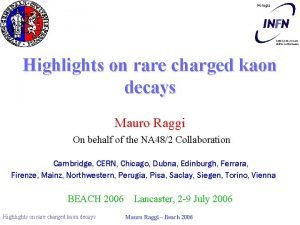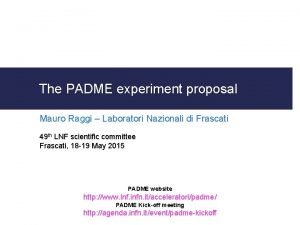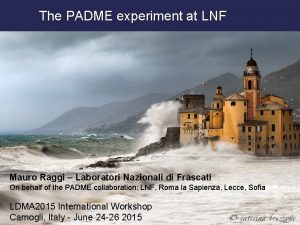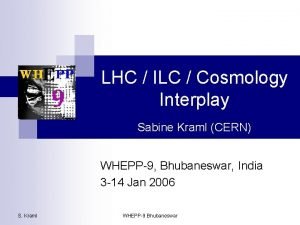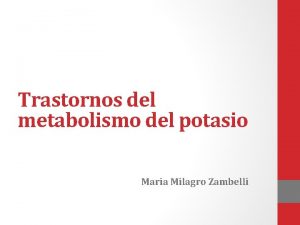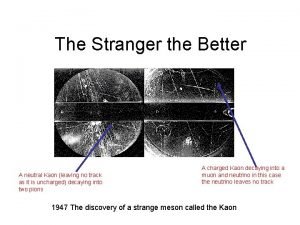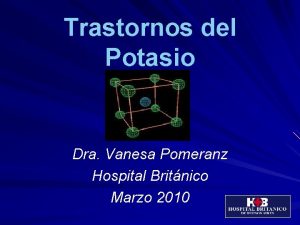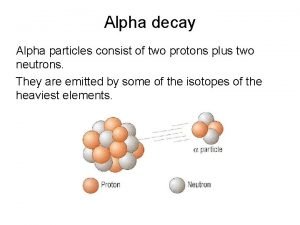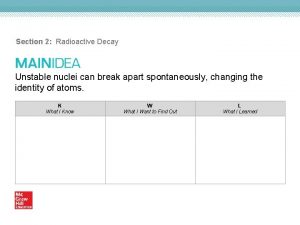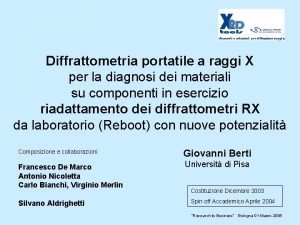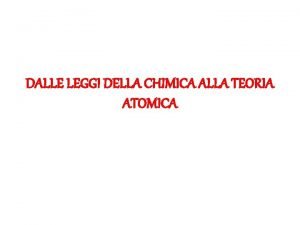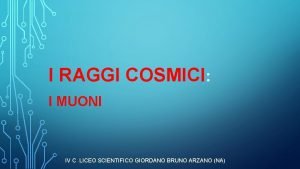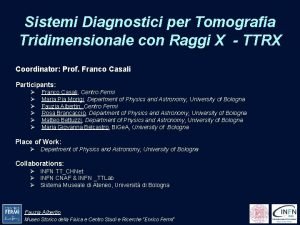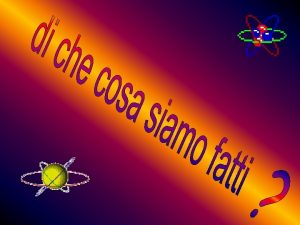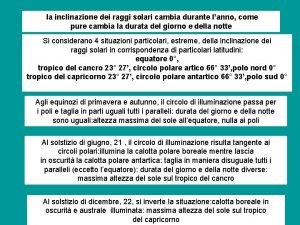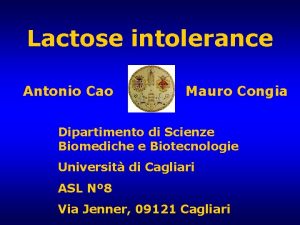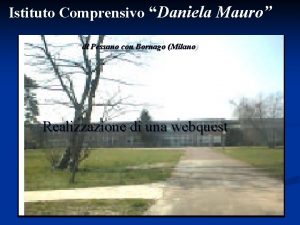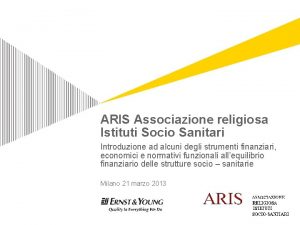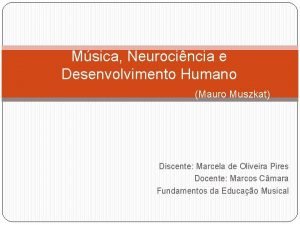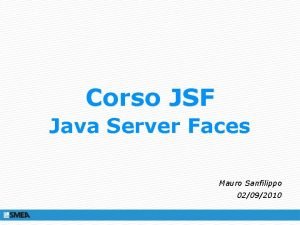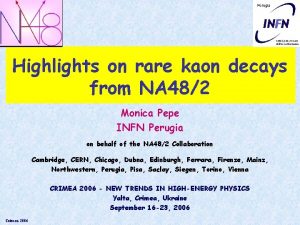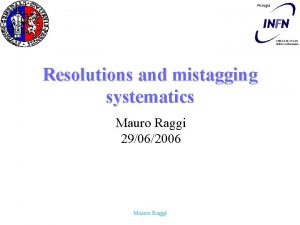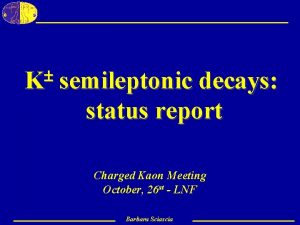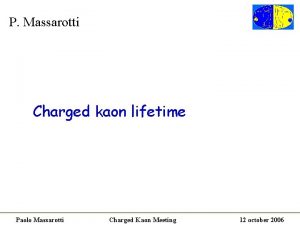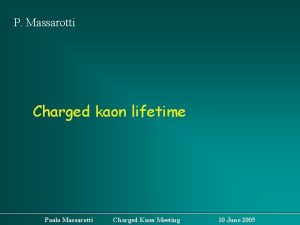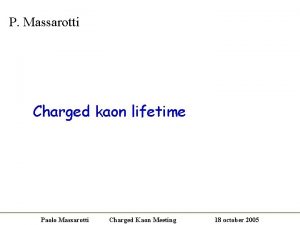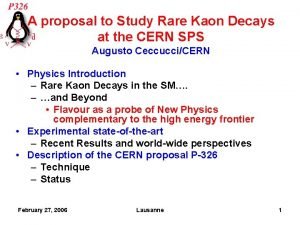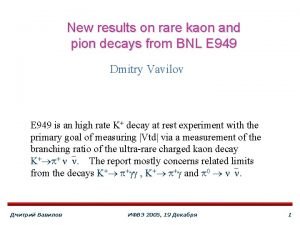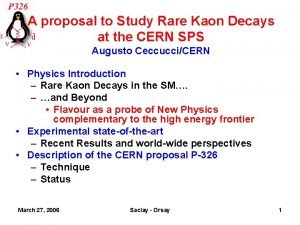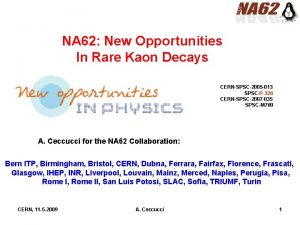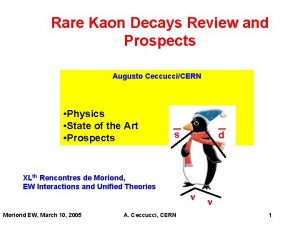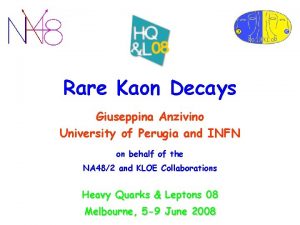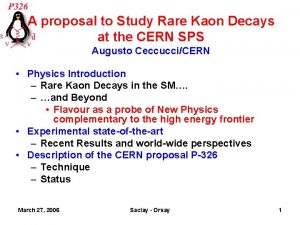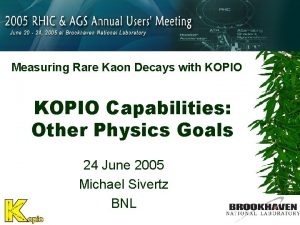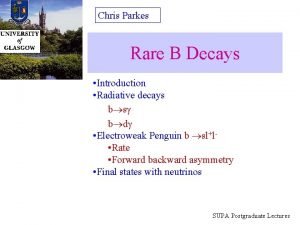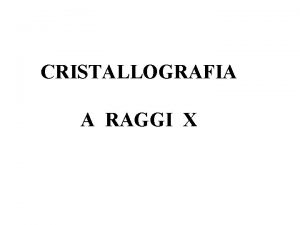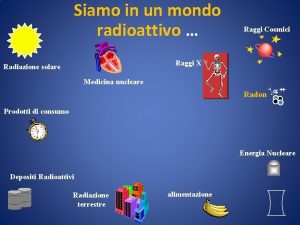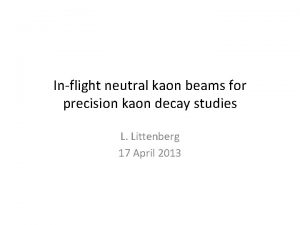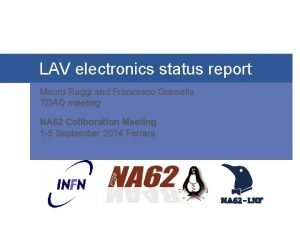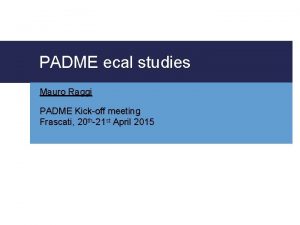Highlights on rare charged kaon decays Mauro Raggi
































- Slides: 32

Highlights on rare charged kaon decays Mauro Raggi On behalf of the NA 48/2 Collaboration Cambridge, CERN, Chicago, Dubna, Edinburgh, Ferrara, Firenze, Mainz, Northwestern, Perugia, Pisa, Saclay, Siegen, Torino, Vienna BEACH 2006 Highlights on rare charged kaon decays Lancaster, 2 -9 July 2006 Mauro Raggi – Beach 2006

Outline ü NA 48/2 experiment ü The decay K±→p±p 0 g: – formalism – experimental status ü NA 48/2 measurement K±→p±p 0 g NEW ü NA 48/2 measurement Ke 400 BR and form factors NEW ü Other rare K charged decays in NA 48/2 Highlights on rare charged kaon decays Mauro Raggi – Beach 2006 2

NA 48/2 detector LKr EM calorimeter Spectrometer - 4 Drift Chambers (DCH) - Magnet Highlights on rare charged kaon decays Mauro Raggi – Beach 2006 3

NA 48/2 beam line Highlights on rare charged kaon decays Mauro Raggi – Beach 2006 4

NA 48/2 data taking periods SS 1 SS 0 SS 2 SS 3 50 days during summer 2003 SS 4 SS 5 SS 6 SS 7 SS 8 ~ 60 days during summer of 2004 Highlights on rare charged kaon decays Mauro Raggi – Beach 2006 5

NA 48/2 RARE DECAYS: 1. K±→p±p 0 g Highlights on rare charged kaon decays Mauro Raggi – Beach 2006 6

Gamma production mechanism IB DE DE IB IB INT DE Inner Bremsstrahlung(IB) : (2. 75± 0. 15)· 10 -4 PDG (2005) (55<T*p<90 Me. V) Direct Emission (DE) : (4. 4± 0. 8)· 10 -6 PDG (2005) (55<T*p<90 Me. V) Interference (INT) : not yet measured Highlights on rare charged kaon decays Mauro Raggi – Beach 2006 7

K→ppg amplitudes ü Two type of contributions: – Electric (J=l± 1) dipole (E 1) – Magnetic (J=l) dipole (M 1) – Electric contributions are dominated by the Inner Bremsstrahlung (EIB) term ü Thanks to Low’s theorem IB contribution can be related to the non radiative decay p±p 0 using QED corrections. ü DE shows up only at order O(p 4) in CHPT ü Is generated by both E and M contributions: – Magnetic contributions are dominated by chiral anomaly – Electric contributions come from L 4 CHPT lagrangian and loops L 2 ü Present experimental results seem to suggest a M dominated DE Highlights on rare charged kaon decays Mauro Raggi – Beach 2006 8

General expression for decay rate DE IB IB INT DE G± depends on 2 variables (W e T*p) that can be reduced to only one integrating over T*p, leading to the above formula where W is a Lorentz invariant variable. The above formula shows the 3 contributions separately: IB, DE, INT. The INT may arise only between the electrical contribution of DE and the IB term. If the INT term near 0 the electrical contributions in the DE term has to be very small. With this parametrization the ratio data/MC(IB) has the form 1+a. W 2+b. W 4 P*K=4 -momentum of the K± P*p=4 -momentum of the p± P*g=4 -momentum of the radiative g Highlights on rare charged kaon decays Mauro Raggi – Beach 2006 9

W distributions for IB, DE, INT The distributions of IB and DE have very different shapes. The distributions are not in scale (IB/DE) ~ 60 because otherwise you can hardly see them but the IB one! Highlights on rare charged kaon decays Mauro Raggi – Beach 2006 10

Experimental results for DE and INT All the measurements have been performed in the T*p region 55 -90 Me. V to avoid p±p 0 p 0 BG All of them are assuming the Interference term to be = 0 Interference measurements: BNL E 787 KEK E 470 Highlights on rare charged kaon decays Mauro Raggi – Beach 2006 11

What’s new in NA 48/2 measurement ØIn flight Kaon decays ØBoth K+ and K- in the beam (possibility to check the CP violation) ØVery high statistics (220 K p±p 0 g candidates of which 124 K used in the fit ) ØEnlarged T*p region in the low energy part (0<T*p<80 Me. V) ØNegligible background contribution < 1% of the DE component ØGood W resolution mainly in the high statistic region ØMore bins in the fit to enhance sensitivity to INT Ø Order ‰ g mistagging probability for IB, DE and INT Highlights on rare charged kaon decays Mauro Raggi – Beach 2006 12

Enlarging T*p(IB) * T p region T*p(INT) T*p(DE) Standard region Use the standard region 55<T*p<90 Me. V is a safe choice for BG rejection (K 3 pn) Unfortunately the region below 55 Me. V is the most interesting for DE and INT measurement This measurement will be performed in the region 0<T*p<80 Me. V to improve statistics and fit stability. Highlights on rare charged kaon decays Mauro Raggi – Beach 2006 13

Reconstruction strategy We can get two independent determination of the K decay vertex: - The charged vertex ZV(CHA) using the K and p flight directions (spectrometer) - The neutral vertex ZV(NEU) imposing p 0 mass to gamma couples (LKr) For the neutral vertex we have 3 values: ZV(12), ZV(23), ZV(13) but only one of those is the correct one. ZV(CHA) LKr ZV(NEU) ZV(2 -3) ZV(1 -3) Highlights on rare charged kaon decays g 2 g 3 g 1 We evaluate the kaon mass for all of them and then choose the vertex giving the best kaon mass. Once the neutral vertex has been chosen we also know what the radiated g is. Mauro Raggi – Beach 2006 14

Main BG sources Decay BR Background mechanism K±→p±p 0 (21. 13± 0. 14)% +1 accidental or hadronic extra cluster K±→p±p 0 p 0 (1. 76± 0. 04)% -1 missing or 2 overlapped gammas K±→p 0 e±n (4. 87± 0. 06)% +1 accidental g and e misidentified as a p K±→p 0 m±n (3. 27± 0. 06)% +1 accidental g and m misidentified as a p K±→p 0 e±n(g) (2. 66± 0. 2)· 10− 4 K±→p 0 m±n(g) e misidentified as a p (2. 4± 0. 85)· 10− 5 m misidentified as a p ü Physical BG rejection: – For p±p 0 we can relay on the cut in T*p< 80 Me. V, MK and COG, cuts – For p±p 0 p 0 we have released the T*p cut, but we can anyway reach required rejection (kaon mass cut (missing g) and overlapping g cut (fused g)) ü Accidental BG rejection (p±p 0, Ke 3(p 0 e±n), Km 3(p 0 m±n)) – Clean beam, very good time, space, and mass resolutions. Highlights on rare charged kaon decays Mauro Raggi – Beach 2006 16

Fused g rejection: overlapping g cut Fused gamma events are very dangerous BG source: - MK, and COG cut automatically satisfied! - Releasing the T*p cut they can give sizable contribution NA 48 calorimeter is very good to reject them: - very high granularity (2 x 2 cm) cells - very good resolution in vertex Z coordinate Zv(p 01) Multi step algorithm looped over clusters: Zv(p 02) Split 1 out of the 3 clusters in two g of energies: eg 1=x. ECL eg 2=(1 -x)ECL now we got 4 gs and we star reconstructing the event as a p±p 0 p 0. Evaluate the ZV(x) pairing the gammas and extract x imposing that: Zv(p 01)= Zv(p 02) same K decay vertex: the 2 p 0 came from the same K! Put x back in the Zv(p 02) to get the real ZV(neu) If the |Zv(CHA)-ZV(neu)|<400 cm Highlights on rare charged kaon decays the g are really fused and so we discard the event Mauro Raggi – Beach 2006 17

BG rejection performance Thanks to the overlapping gamma cut and to MK and COG resolutions, the BG coming from p±p 0 p 0 is under control. Source p±p 0 p 0 %IB %DE ~1· 10 -4 ~0. 61· 10 -2 • K±→p±p 0 p 0 Accidental <0. 5· 10 -4 ~0. 3· 10 -2 • K±→p±p 0 g Selected region 220 K events All physical BG can be explained in terms of the p±p 0 p 0 events only. Very small contribution from accidentals neglected Total BG is less than 1% with respect to the expected DE contribution even in the range 0<T*p<80 Me. V Highlights on rare charged kaon decays Mauro Raggi – Beach 2006 18

The mistagged g events: a self BG The mistagged gamma events behave like BG because they can induce fake shapes in the W distribution. In fact due to the slope of IB W distribution they tend to populate the region of high W simulating DE events. The rejection of mistagged events has 2 steps: 1. Compatibility of charged and neutral vertices (2. 5% mistagging) 2. Distance between best and second best neutral vertices > xx cm ■ DE ▼IB The mistagging probability has been evaluated in MC as a function of the mistagging cut to be 1. 2‰ at 400 cm Mistagging probabilities for IB and DE events are very similar. Highlights on rare charged kaon decays Mauro Raggi – Beach 2006 19

Data MC comparison The IB dominated part of the data W spectrum is very well reproduced by MC The radiated g energy (for the IB part of the spectrum) is very well reproduced W(Data)/W (IBMC) Data MC for Eg (W<0. 5) IB dominated region Fitting region Egmin cut Highlights on rare charged kaon decays Mauro Raggi – Beach 2006 20

Fitting algorithm To get the fractions of IB(a), DE(b), INT(g), from data we use an extended maximum likelihood approach: The fit has been performed in 14 bins, between 0. 2 -0. 9, with a minimum g energy of 5 Ge. V, using a data sample of 124 K events. To get the fractions of DE and INT the raw parameter are corrected for different acceptances Highlights on rare charged kaon decays Mauro Raggi – Beach 2006 21

Systematic uncertainties Many systematic checks have been performed using both data and Monte-Carlo Effect Syst. DE Syst. INT Energy scale +0. 09 -0. 21 Fitting procedure 0. 02 0. 19 LVL 1 trigger ± 0. 17 ± 0. 43 _ ± 0. 2 LVL 2 Trigger ± 0. 17 ± 0. 52 Resolutions difference <0. 05 <0. 1 LKr non linearity <0. 05 BG contributions <0. 05 TOTAL ± 0. 25 ± 0. 73 Mistagging Systematic effects dominated by the trigger! Learning from experience both LVL 1 and LV 2 triggers have been modified in 2004. We are confident that both systematics will be reduced in 2004 data set. Highlights on rare charged kaon decays Mauro Raggi – Beach 2006 22

y Pr eli mi na r Fit results First measurement: in the region 0<T*p<80 Me. V and of the DE term with free INT term. First evidence of a non zero INT term The error on the results is still dominated by statistics and we could profit of SS 0 and 2004 data to reduce statistical uncertainties. Unfortunately parameters are highly correlated Highlights on rare charged kaon decays Mauro Raggi – Beach 2006 23

INT=0 fit: just for comparison Just for comparison with what other experiments did we have also extracted the fraction of DE, with the INT term fixed to 0 in the region 55 -90 Me. V. A likelihood fit using IB & DE MC only has been performed in the region 0<T*p<80 Me. V. Extrapolating to the 55 -90 region using MC we get: The analysis of fit residuals shows a bad c 2 Description in term of IB+DE only is unable to reproduce W data spectrum. Highlights on rare charged kaon decays Mauro Raggi – Beach 2006 24

NA 48/2 RARE DECAYS: 2. K±→p 0 p 0 e±n (K 00 e 4) Highlights on rare charged kaon decays Mauro Raggi – Beach 2006 25

Introduction to 00 Ke 4 ü Form factors are good constraint for CHPT Lagrangian ü Low energies p-p pairs can be used for scattering length measurements as in Ke 4 C ü Also Ke 400 is expected to have a CUSP ü Best measurement by E 470 based on 216 events – BR(Ke 400)=(2. 29 ± 0. 33)· 10 -5 – Attempt to fit form factor F Highlights on rare charged kaon decays Mauro Raggi – Beach 2006 26

Measurement technique for BR ü The Kaon flux has been measured using K±→p±p 0 p 0: ü For the BR(K±→p±p 0 p 0) new result from KLOE has been used: BR(K±→p±p 0 p 0)=1. 763± 0. 013± 0. 022 Highlights on rare charged kaon decays Mauro Raggi – Beach 2006 27

Event selection Ø≥ 4 good g clusters in LKr Ø≥ 1 good track with E/p ≥ 0. 95 Ø 2 good p 0 with similar ZV vertex position (Neutral vertex) Øshower width cut to distinguish e and p ØUse the K for momentum from KABES to evaluate n momentum assuming PT=0 Ø The Kaon mass can be evaluated Highlights on rare charged kaon decays Mauro Raggi – Beach 2006 28

BG estimates 1. K±→p±p 0 p 0 →same final state of signal IF p misidentified as an e - E over P and shower width cut to identify hadronic showers from EM ones - Elliptic cut in the PT and MK(p±p 0 p 0) plane to identify p±p 0 p 0 decays 2. K±→e±p 0 n(g) → plus an accidental g 9642 events with the following BG: 260± 94 from K±→p±p 0 p 0 16 ± 2 accidental BG form Ke 3(g) Quite clean sample BG less than 3% Highlights on rare charged kaon decays Mauro Raggi – Beach 2006 29

Final result BR y Pr eli mi na r Using only the SS 123 part of the 2003 data (9642 events) the Branching Ratio of the Ke 400 decay has been measured: The result has been crosschecked using also Ke 3 as normalization channel leading to consistent result. The statistical error can be further reduced using the 2004 data set (28 K events) Highlights on rare charged kaon decays Mauro Raggi – Beach 2006 30

The 00 Ke 4 form factors In this case we have only 1 form factor F (2 identical p 0): The fit has been performed using both 2003 and 2004 data (~38 K events) No sensitivity to fe reached → fe set to 0. Under this assumption we get: Those values are consistent with the ones measured by NA 48/2 in Ke 4 C See detailed talk by B. Bloch-Devaux at QCD 2006 conference. Highlights on rare charged kaon decays Mauro Raggi – Beach 2006 31

K±→p±gg and other NA 48/2 rare decays K±→p±gg Low mgg spectrum limited in the main trigger by a trigger cut around 200 Me. V/c 2 Maybe we can look in the lower region using minimum bias triggers and 2004 dataset Decay # Ev. NA 48/2 # Events BR K±→p±gg 2000 (SS 123) 31 (E 787) BR(100<P<180)=(6. 0± 1. 5 sta± 0. 7 sys)10− 7 K±→p±e±e± 4000(SS 123) 10 K (E 787) (2. 88± 0. 13)· 10 -7 402 PDG ’ 05 (8. 1± 1. 4) · 10 -8 K±→p±m±m± Highlights on rare charged kaon decays Mauro Raggi – Beach 2006 32

Conclusions Pr eli m ina ry ü NA 48/2 has performed the first measurement of the DE and INT terms in the region 0<T*p<80 Me. V for the decay K±→p±p 0 g: Pr eli mi na ry ü The results seem to indicate the presence of a negative, non vanishing, interference and therefore a non negligible contribution of E terms to the DE. ü A new measurement of the BR and form factor parameters for the Ke 400 decays has also been performed: ü Both results can be further improved using SS 0 and 2004 statistics ü Much more to come in other rare decays Highlights on rare charged kaon decays Mauro Raggi – Beach 2006 33
 Mauro raggi
Mauro raggi Raggi no vac
Raggi no vac Mauro raggi
Mauro raggi Kaon cp violation
Kaon cp violation Hipokalemia
Hipokalemia Kaon
Kaon Causa de hipokalemia
Causa de hipokalemia U-238 alpha decay
U-238 alpha decay Nuclear decays and reactions section 2
Nuclear decays and reactions section 2 Area segmento circolare
Area segmento circolare Raggi-x portatili
Raggi-x portatili Le particelle che costituiscono i raggi anodici
Le particelle che costituiscono i raggi anodici Raggi cosmici
Raggi cosmici Tomografia a raggi x
Tomografia a raggi x Raggi midollari di ferrein
Raggi midollari di ferrein I raggi gamma
I raggi gamma Circolo di illuminazione
Circolo di illuminazione What is principle of art
What is principle of art Proposal highlights
Proposal highlights Highlights from the book of isaiah
Highlights from the book of isaiah Highlights memorandum
Highlights memorandum My work attitude at work immersion
My work attitude at work immersion Investment highlights
Investment highlights The passage highlights……
The passage highlights…… Key highlights icon
Key highlights icon Highlights from the book of isaiah
Highlights from the book of isaiah Green village cittadella
Green village cittadella Antonio cao
Antonio cao Scuola daniela mauro
Scuola daniela mauro Aris associazione
Aris associazione Mauro muszkat
Mauro muszkat 02092010
02092010 Mauro varotto
Mauro varotto
